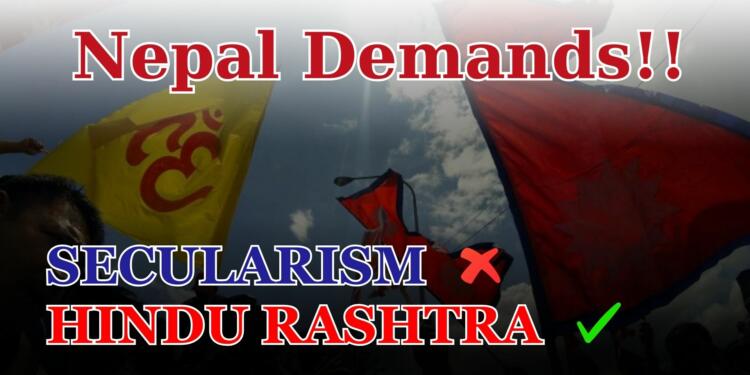In Nepal’s intricate sociopolitical landscape, the resurgence of Hindu nationalism emerged as a potent force, challenging the country’s transition to secularism in 2008. Rooted in centuries of monarchy and Hindu tradition, this movement advocates for the restoration of Nepal as a Hindu Rashtra, sparking contentious debates and reshaping national identity dynamics. Spearheaded by political parties like the Rastriya Prajatantra Party (RPP) and influential figures such as former Prime Minister Khadga Prasad Oli, the call for a Hindu state intersects with complex sociocultural dynamics, including ethnicity, caste, and religion.
Historical Context
Nepal’s historical identity has long been intertwined with its status as a Hindu kingdom, shaped by centuries of monarchy and religious tradition. However, the trajectory of Nepal’s national identity took a significant turn in 2008 with the transition to a secular state, marking a pivotal moment in its sociopolitical landscape.
Legacy of Hindu Monarchy
For centuries, Nepal was characterized by a Hindu monarchy, where the ruling elite, particularly under King Mahendra’s reign (1955-1972), promoted a unified national identity centered around Hinduism. King Mahendra’s mantra of “ek raja, ek desh, ek bhasa, ek bhesh” (one king, one state, one language, one dress) aimed to consolidate power and foster a sense of unity among the diverse ethnic groups within Nepal. This vision cemented the monarchy’s association with Hinduism, positioning the king as the embodiment of Lord Vishnu, a revered Hindu deity.
The emergence of Calls for Secularism
However, the seeds of secularism were sown during Nepal’s political revolution in 1990, which saw the overthrow of the executive monarchy and the establishment of a parliamentary democracy with a constitutional monarchy. As leaders from ethnic communities spearheaded the movement for change, calls for Nepal to become a secular state gained momentum. Ethnic minorities, particularly those from the southern plains, sought to challenge the dominance of the upper-caste elite and redefine Nepal’s national identity to be more inclusive and reflective of its diverse population.
Transition to a Secular State
The culmination of these efforts came in 2008 with the formal declaration of Nepal as a secular state in its interim constitution. This transition represented a fundamental shift away from the centuries-old Hindu monarchy towards a more pluralistic and inclusive vision of the nation. By embracing secularism, Nepal sought to uphold religious and cultural freedoms while moving away from the privileging of Hinduism as the state religion.
Political Landscape
In Nepal’s intricate political landscape, the discourse surrounding the restoration of Hindu monarchy and statehood has been a contentious issue, with various political parties and influential figures actively advocating for this cause. Understanding their roles sheds light on the dynamics shaping Nepal’s sociopolitical environment.
Rastriya Prajatantra Party (RPP)
At the forefront of the movement to reinstate Nepal as a Hindu kingdom stands the Rastriya Prajatantra Party (RPP). With a staunch royalist stance, the RPP champions the restoration of constitutional monarchy and the re-establishment of Nepal as a Hindu state. Despite facing electoral setbacks, the RPP remains steadfast in its pursuit, appealing to sentiments of cultural heritage and tradition among sections of the population.
Former Prime Minister Khadga Prasad Oli
Khadga Prasad Oli, a prominent political figure known for his nationalist rhetoric, has played a significant role in fueling Hindu nationalist sentiment in Nepal. Despite publicly endorsing secularism, Oli’s actions often cater to Hindu nationalist sentiments. His gestures, such as visiting sacred Hindu sites and promoting Hindu-centric policies, resonate with a populace nostalgic for Nepal’s Hindu monarchy era. Oli’s strategic alignment with Hindu nationalism serves to consolidate his political base and reinforce his image as a defender of Nepal’s cultural identity.
The Maoists
The Maoist movement, despite its communist ideology, has also engaged in stoking Hindu nationalist sentiment as a means of garnering support. While initially advocating for secularism during Nepal’s transition to democracy, certain factions within the Maoists have embraced Hindu nationalism to broaden their political appeal. By tapping into cultural and religious identities, the Maoists aim to mobilize segments of the population disillusioned with the secular state. This shift underscores the complexities within Nepal’s political landscape, where ideological boundaries blur in pursuit of political objectives.
Also Read: From Sacred Stones to Modern Marvels: Modi’s Trail in UP & Jammu
Sociocultural Dynamics
In Nepal, the discourse on Hindu nationalism is deeply intertwined with complex sociocultural dynamics, including ethnicity, caste, and religion. Understanding these intersections provides insight into the multifaceted nature of the movement and its implications for marginalized communities and perceptions of external influence.
Intersection of Ethnicity, Caste, and Religion
Nepal’s diverse population comprises various ethnic groups and castes, each with distinct cultural identities and historical experiences. The discourse on Hindu nationalism often intersects with these identities, as certain groups perceive themselves as the guardians of Nepal’s Hindu heritage. For some, Hindu nationalism serves as a unifying force, reinforcing a sense of collective identity rooted in religious tradition.
Tensions with Marginalized Communities
The rise of Hindu nationalism in Nepal has also heightened tensions with marginalized communities, particularly those advocating for greater recognition and rights. For Dalits, indigenous peoples, and other marginalized groups, the emphasis on Hindu identity can perpetuate discrimination and exclusion, reinforcing existing power dynamics that privilege certain castes and ethnicities.
Perception of Western Interference
Amidst the discourse on Hindu nationalism, there is a prevalent perception of Western interference in religious proselytization, particularly by international NGOs and missionary organizations. Some proponents of Hindu nationalism view Western influence as a threat to Nepal’s cultural and religious identity, fueling suspicions of external agendas aimed at undermining Hindu traditions.
International Factors
The relationship between Nepal’s Hindu nationalism and its neighbor, India, particularly through political entities like the Bharatiya Janata Party (BJP) and the Rashtriya Swayamsevak Sangh (RSS), is a critical aspect shaping the discourse and trajectory of the movement. Understanding India’s role provides insight into the external dynamics impacting Nepal’s internal affairs.
Promotion of Hindu Nationalism
The BJP and RSS, both prominent Hindu nationalist organizations in India, have historically maintained close ties with like-minded groups in Nepal. These ties have facilitated the promotion of Hindu nationalism as a shared ideology across borders, with Indian leaders openly advocating for Nepal’s return to Hindu statehood.
Actions by Indian Leaders
Indian leaders, including prominent figures like those from the BJP, have publicly endorsed the idea of Nepal reverting to a Hindu state. Such statements reflect a broader sentiment within certain segments of Indian politics that view Nepal’s secular status as a departure from its traditional identity.
Funding by Right-Wing Religious Groups
There are allegations of financial support from right-wing religious groups affiliated with the BJP and RSS to Nepali organizations advocating for the restoration of Hindu monarchy and statehood. These allegations suggest a coordinated effort to influence Nepal’s internal affairs and advance the agenda of Hindu nationalism.
Challenges and Controversies
The push for a Hindu Rashtra (nation) in Nepal faces a myriad of challenges and controversies, reflecting the complexities inherent in reshaping the country’s identity and governance structure. From opposition by secularists to internal divisions within political parties, and tensions with neighboring India, proponents of a Hindu state must navigate a landscape fraught with obstacles.
Opposition from Secularists
One of the primary challenges faced by proponents of a Hindu Rashtra in Nepal is opposition from secularists and advocates of pluralism. Secular voices argue that embracing Hindu nationalism undermines the principles of religious freedom and inclusivity enshrined in Nepal’s constitution. They warn against privileging one religious identity over others, advocating instead for a secular state that respects the rights and beliefs of all citizens.
Concerns about Religious Freedom
The promotion of Hindu nationalism also raises concerns about religious freedom and the rights of minority communities in Nepal. Critics argue that institutionalizing Hinduism as the state religion could marginalize non-Hindu groups and limit their ability to practice their faith freely. This poses a significant challenge for proponents of a Hindu Rashtra, who must address these concerns while advancing their agenda.
Internal Divisions within Political Parties
Internal divisions within political parties further complicate the push for a Hindu Rashtra. While some factions within parties like the Rastriya Prajatantra Party (RPP) advocate for the restoration of Hindu monarchy and statehood, others may prioritize other issues or adopt a more moderate stance on religious identity. These internal tensions hinder cohesive action and consensus-building within the political sphere.
Controversies Surrounding Hindu Nationalism and Monarchy
The link between Hindu nationalism and the monarchy in Nepal is a subject of controversy and debate. While some proponents of a Hindu Rashtra view the monarchy as integral to preserving Nepal’s Hindu identity, others argue that separating the two is necessary to uphold democratic principles and ensure inclusive governance. This internal rift underscores the complexities of reconciling historical traditions with contemporary political realities.
Future Implications
The rise of Hindu nationalism in Nepal carries profound implications for the country’s political landscape, social cohesion, and regional geopolitics. As the movement gains momentum, its trajectory is poised to shape Nepal’s future in significant ways, with ripple effects extending beyond its borders.
Social Cohesion
The Hindu nationalist movement’s ascendancy could fundamentally alter Nepal’s political landscape, potentially leading to a reconfiguration of power dynamics and ideological alignments. Proponents of a Hindu Rashtra may seek to consolidate their influence within political parties and institutions, leading to shifts in policy priorities and governance structures.
However, the movement’s exclusionary tendencies and emphasis on Hindu identity risk exacerbating divisions within Nepali society, particularly along religious and ethnic lines. Marginalized communities, including Dalits, indigenous peoples, and religious minorities, may face increased discrimination and marginalization, undermining efforts to foster social cohesion and inclusivity.
Relations with Neighboring Countries
The implications of Nepal’s Hindu nationalist movement extend beyond its borders, with potential ramifications for regional geopolitics and relations with neighboring countries, particularly India. India’s support for Hindu nationalism in Nepal reflects broader strategic interests and cultural affinities, but it also risks complicating bilateral relations and fueling tensions. As Nepal asserts its identity and sovereignty through the promotion of Hindu nationalism, it may encounter resistance or apprehension from India, which seeks to maintain influence and stability in the region.
In conclusion, Nepal stands at a critical juncture as it grapples with the resurgence of Hindu nationalism amidst its transition to secularism. The movement’s ascent, propelled by political parties, influential leaders, and external influences like India’s BJP, underscores the complexities inherent in reshaping national identity and governance structures.































